 |
|||||||||||
| Gershman Acoustics' lovely Ofra introduced me to new finishes in their line, as well as a new three-layer acoustic treatment panel dubbed Acoustic Art because it can be finished in any designer fabric imaginable [see on-wall below]. |
|||||||||||
 |
|||||||||||
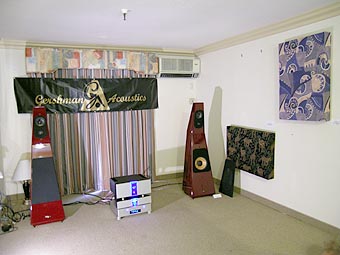 |
|||||||||||
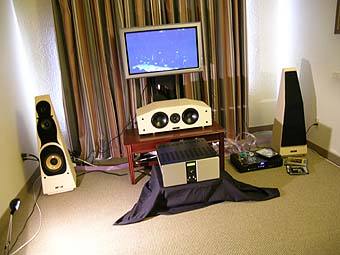 |
 |
||||||||||
I've always admired the classy Burgundy lacquer option available on the GAP-828 and AvantGarde Gershman models. Alas, my trailer-trash mentality couldn't conceive of an entire palette of automotive and other lacquer finishes awaiting customer dictation to maximize visual harmony within any domestic environment. Making this point loud enough to finally penetrate my thick skull, Ofra asked me to inspect the new Antique White Crackle finish they had applied to their surround-sound speaker setup in the adjacent room. Caramba - now I gotz it: Certain Gershman models can be had in all the colors of the rainbow. Viva la choice. |
|||||||||||
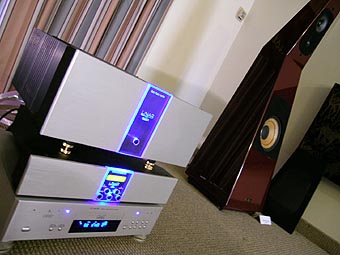 |
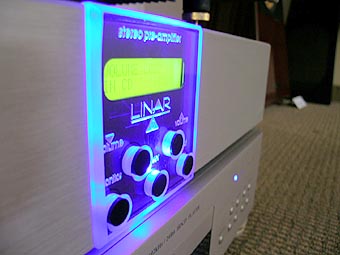 |
||||||||||
| While we're at skulls impenetrable, thick and dense -- though the Skulls and Bones motif belongs to our own Jim Saxon -- I had never before spied the Linar Audio electronics which Gershman used to power their speakers with. Brain child of Victor Sima, the original founder of Sim Audio. this new brand has 25 years of HighEnd experience behind it and displayed the Model 2 preamplifier and Model 250 power amp. One core philosophy of Linar is the avoidance of any global feedback to reduce T.I.M. or transient intermodulation, as well as to prevent loudspeaker back EMF from penetrating the amplifier circuit. Linar amplifiers are thus zero NFB transistor designs. The Model 2 preamplifier uses J-FETs, a single gain stage, no feedback, micro-processor-controlled, direct-coupled, resistor-ladder attenuation and full-function remote. Visit their website to learn more. Appearing in the Gershman room is endorsement enough to suggest a winner. |
|||||||||||
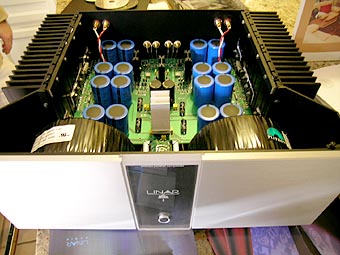 |
|||||||||||
Entering the Grommes-HiFi room was akin to a time warp. Not only did their 260/260 Limited Reissue and 360 amps clearly harken from days gone by -- albeit completely overhauled and modernized to play in the 21st century -- but I remembered marketing director Albert Schippits from the Chicago store Holmes Audio. I used to call on him during my manufacturing days. Albert was fond of giving me major shit over members in my dealer network that were guilty of treason, i.e. occasional discounting - at least according to Schippits who took such matters extremely personal. With the tables now turned since Grommes intends to pursue a dealer network, Albert will have to wrestle with the same demons of transshipping, back door sweetheart deals and on-line dumping which have only grown more prevalent since my days of duty in the audiophile sales trenches. Good luck, Albert! Perhaps now you realize that idealistic theory and marketplace reality are more difficult to bring into common focus than it may have appeared to a hardworking salesman who was understandably intent on not loosing sales to competing dealers that operated on the sideways of the high road. |
|||||||||||
 |
 |
||||||||||
For a history lesson on Grommes, visit their main site, Groomes-Precision - you'll quickly appreciate that their CES offerings didn't just drop out of the sky or materialize out of a vacuum but constitute literal decades worth of sales and experience. |
|||||||||||
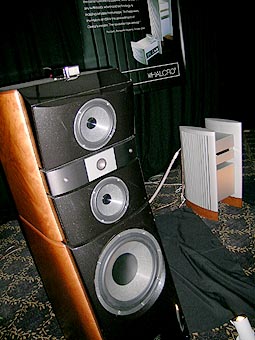 |
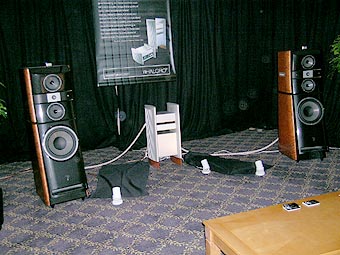 |
||||||||||
| Halcro and JMlab hosted one of a number of über-exhibits which combined the best and most expensive our industry has to offer, in ballrooms and suites far larger than most end users could ever dream of inhabiting. And therein lies what at least to these ears seems a very real rub. |
|||||||||||
| To fill a large room takes high SPLs - not to play loud, but to get normal levels at your ear while suffering acoustic losses due to huge cubic air volumes. Playing loud without compression or distortion means power, power, power - and special transducers that can swing the requisite excursions without defaulting into nonlinearities. None of these über-systems suffered audible distortion or compression, high praise indeed for achieving something very difficult under such circumstances. But here's the paradox: Why attempt something that no HiFi enthusiast will ever duplicate? Listening to music at home involves a particular intimacy which is a function of reduced scale. Clearly, a 100-head orchestra would never fit into your space even if you shrunk their heads. Even a 5-piece Jazz combo with spread-out drum kit and the kind of distances that exist naturally between performers on-stage might be stretching it when you consider the actual amount of floor space your current system inhabits. The emotionally most compelling systems at CES never attempted the truly grand scale in that elusive chase of the perfect copy of the live event. While reduced in scale, their focus was on delivering the feel, vibe, gestalt and experience of the real thing. Though a daunting task when you really consider it, many of them came close or actually succeeded. The über-systems succeeded too, albeit in a different arena. Theirs were scientific feats - which curiously addressed the heartstrings far less, instead invoking mental and conceptual awe over brilliant technical achievements that seemed curiously hollow in the feeling dimension - which, let's not kid ourselves, is the heart and soul of music. Play the wrong notes, play out of tune if you must, but play with goddamn feeling. Right? So that's my question then - why attempt the unrealistically grande scale when something invariably gets lost in the process? More to the point: Why attempt it when it's not a viable blueprint for 9,999 out of 10,000 listeners who live in average homes, not mansions or castles? |
|||||||||||
| JJ Electronics from the Slovak Republic is well-known for their tubes but perhaps less so for their own valve electronics. Those include the 20-watt JJ322 SET amp with paralleled 300Bs; the 10-watt JJ239 monoblock with 2A3 or 300B output triode; the 70-watt JJ828 integrated amplifier with 8xKT88; and the JJ243 tube preamplifier with phono stage. Perusing their press materials, I learned that this firm employs 150 people, indicating quite the - er, grande scale of operations, especially when you consider the limited market for tubes as compared to semi-conductors. JJ's tube lineup includes: the ECC81/82/83S/832/88/99/ small-signal double triodes; the EL84/34/34L output pentodes; the 6L6 GC/KT88 beam pentodes; the 300B triode; a 40-watt version of the 2A3 triode; the GZ34S double-anode rectifier; and, new for 2004, the 6V6S beam pentode. |
|||||||||||
 |
|||||||||||
| KR Audio's mighty 42-watt Kronzillas DM monoblocks with twin 1610 power triodes, perched atop the equally sizable EquaRack stands, were testament once again to Riccardo Kron's unrelenting vision of dedicating his personal resources to the invention and fabrication not of existing tube designs -- though he did that too -- but to develop new, high-current variants that would bridge the gap between tone and drive, beauty and raw muscle. Having owned both the Art Audio Jota and PX-25 which used KR Audio output tubes exclusively, my personal experience of these valves has been one of utter reliability, allowing behavior as nonchalant as leaving an amplifier under signal for one week solid, 24/7 while on the road to hasten break-in. There's not many tube amps I'd dare that with, but the KR tubes never signaled that they should be treated with kid's gloves. |
|||||||||||
 |
|||||||||||
Needless to say, quality and longevity cost money, especially when you're looking at protracted hand labor by very skilled artisans. That's why music lovers in the US should applaud Sean Ta of AYDN for his decision to sell KR Audio products consumer-direct from his California headquarters. As KR's chosen exclusive distributor, this has the full consent and blessing of Eunice Kron behind it and includes on-site warranty repairs and tube matching facilities. To sell direct or through dealers - this is the new conundrum modern-day audiophile Hamlets must ponder. I predict that we'll see further evidence in support of the direct model this year as the market continues to overcrowd while Asian and former Iron Curtain nations proceed to offer more and more high-quality wares for aggressively low pricing in our deal-conscious society. |
|||||||||||
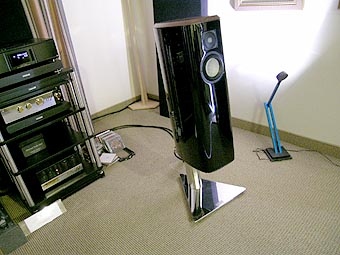 |
|||||||||||
 |
|||||||||||
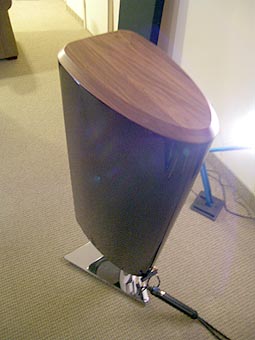 |
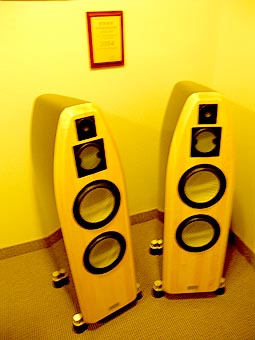 |
||||||||||
| Mårten Design's 2003 launch of the now $50,000 Coltranes [right] was followed up by this year's introduction of the Coltrane Alto [$22,000/pr] which, in a very attractive and moderately sized package, manages to hide a down-firing woofer [above right] to offer spectacularly fast and precise full-range sound from a Carbon-fiber cabinet with Cherry, Maple, Oak or Walnut top panel. With its chromed integral stand, the Alto cut a very dapper, distinctly Scandinavian hi-tech profile and could be a God-sent for decor-conscious high-performance shoppers. | |||||||||||
Like countless other importers getting hammered by the Euro's ascendancy over our dollar, Mårten Design distributor Dan Meinwald of E.A.R.-USA had to raise prices to keep up with the Jones in the European Community. The Monk now sells for $4,400/pr; the Mingus III which I recently reviewed for $7,000/pr; and the Miles II for $10,000/pr. If you consider Mårten Design's focus on the ceramic Accuton drivers from Germany's Thiele & Partners -- which also appear in Avalon, Lumenwhite, Kharma and Talon designs -- this pricing is still some of the lowest in these leagues but clearly upscale territory nonetheless. As I noted in my review, Accuton drivers seem to be tuned for speed and accuracy, mandating an infusion of body and bloom vis-à-vis the preceding electronics. Dan pulled this off by mating his Coltrane Altos to Tim de Paravicini's E.A.R. tube electronics for a match made in Heaven. If you enjoy the dynamics, agility and focus of good horn-loaded speakers, these Mårtens will get you 90% of the way in a very living-room-friendly package. |
|||||||||||
 |
|||||||||||
 |
|||||||||||
 |
|||||||||||